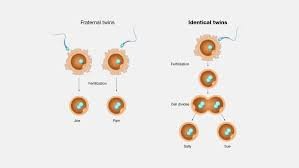How Identical Twins' DNA Reveals the Depth of Genetic Similarity
identical twins are identical because they share the same DNA, with a rare case of mutation. Otherwise, it's all the same. The twin zygosity DNA test helps to determine if your twins are identical twins or fraternal twins.

Identical twins are literally identical in every regard, from features to their habits. Sometimes, it becomes difficult to recognize the two or differentiate them based on their facial features. Identical twins are born out of the same fertilized eggs, so technically, they have identical twins' DNA. It means the twins share the same genetic sequencing. In that regard, sometimes, it offers challenges to the relationship between DNA and testing. However, there can be exceptions as well. In this post, we will try to explain how identical twins are genetically similar.
What makes Identical Twins Genetically Identical?
Another name for identical twins is monozygotic twins. The science behind identical twins is fascinating. It is the result of the fertilization of a single egg by a single sperm. Then, the fertilized egg gets split into two, giving birth to identical twins. Identical twins mostly share the same genetic sequencing and are mostly the same sex.
In addition to this, there might be changes in the sequencing due to environmental factors and mutations, but identical twins have identical twin DNA. According to a 2021 study, about 15% of similar twin pairs may have one pair that exhibits different characteristics and genetic sequencing. In that regard, it becomes a rare event to have distinctive DNA. This opens new doors for researchers to study DNA for relationship testing.
What is the Role of Identical Twins in Relationship Testing?
According to studies, identical twins are identical because they share the same DNA, with a rare case of mutation. Otherwise, it's all the same. The twin zygosity DNA test helps to determine if your twins are identical twins or fraternal twins. The results of the test are highly accurate, at 99% to 100%.
Apart from that, when it comes to relationship DNA testing, identical twins pose serious challenges. As they do not have different features, it might be difficult to distinguish between them in relationship testing, such as paternity and sibling tests. As per studies, since they are identical twins, thus they cannot be studied using standard forensic DNA testing, but there is a need for advanced technology such as next-generation sequencing. The paternity testing relies on the 16 -24 short tandem repeat markers. However, identical twins have microsatellite profiles that cannot be distinguished.
Identical Twins and Facial Recognition Technology
According to a study, identical twins may have different facial features. However, the main key areas, such as eye color or shape and nose, are controlled by genes. So, people and experts perceive them as identical. Facial recognition is the advanced technology or the system that helps find the person through facial features. In forensic testing, facial recognition plays an integral role. However, facial recognition becomes complicated or even fails to differentiate between the two.
In many cases, twins can unlock each other's mobile phones using a face lock. However, it raises questions about the authenticity of the technology. It calls for advanced facial recognition technology to differentiate between the two.
Environmental Factors and Epigenetics in Identical Twins
Identical twins come from the same egg, so they share the same features and even the genetic sequencing. This seems fascinating, but it calls for advanced DNA technology. In studies, the changes may occur due to environmental factors. According to recent studies, twin identicals share unique epigenetics. In a study, they studied 40 pairs of monozygotic twins. About 65% of twins had the same genetic profile due to Epigenetics. However, 35% had different profiles. Not only this, but there was a clear difference in heights and some facial features. They further state that it has been made possible through environmental changes and impact.
What are the Real World Applications for Studying Identical Twins?
Twins contribute a lot to different studies. For example, if one twin gets cancer but the other does not. Then, the researcher can analyze the genes of both twins to identify the main difference in the sequencing. This also helps in assessing the risk of cancer in another twin. In the real world, they have been working on developing new technology for evaluating twins. For example, NIPP, which stands for non-invasive prenatal paternity testing, is not possible on twins as they do not have the advanced technology to separate two free-floating fetal DNA from the mother’s blood.
Conclusion
Identical twins are related to each other on every level, from facial features to habits. However, the environment does play a role in bringing about some changes. However, the number of changes is minor as the majority of the twins have the same genetic sequencing. Nevertheless, one aspect of sharing the same genetic sequencing is that it helps the researcher to find the change if one gets cancer or any other genetic condition. Choice DNA Testing lab may offer help as they offer all kinds of genetic testing.
What's Your Reaction?


















